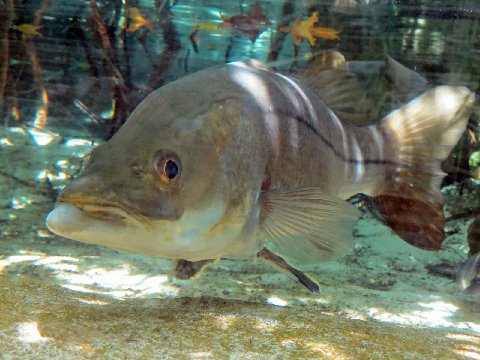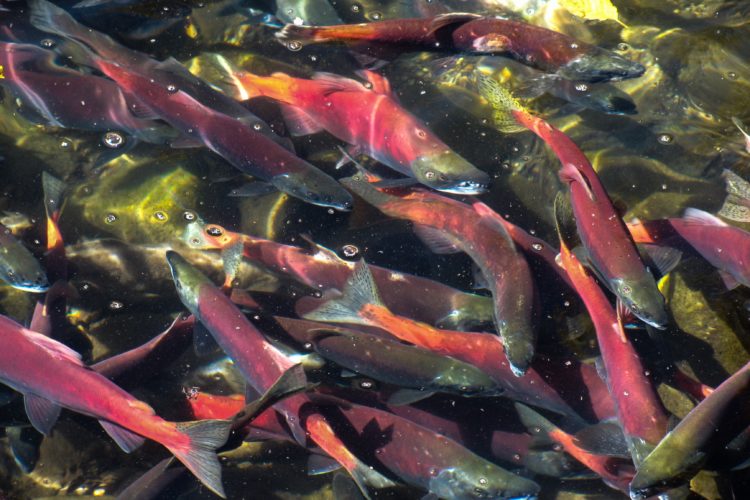We have much more to do and your continued support is needed now more than ever.
How Fish Are Being Affected by Climate Change
From land to sea, climate change has affected wildlife by amplifying pre-existing stressors such as invasive species, diseases and habitat loss.

For marine life two irreversible challenges, posed by climate change, are increasing water temperatures and ocean acidification. Like a sponge, the ocean soaks up atmospheric heat and greenhouse gases such as carbon dioxide (CO2). Over the last ten years, our oceans have absorbed 90 percent of additional warming due to the greenhouse effect and one-fourth of human CO2 emissions.
As the ocean absorbs more CO2 from the atmosphere, a series of chemical reactions occur that cause its pH level to decrease, meaning it becomes more acidic. This lowers the amount of carbonate ions available, which are used to help build shells or skeletons for oysters, clams, corals, crabs, pteropods, and more. These underwater animals are the building blocks of life for our oceans and if their populations were to decrease it would disrupt the entire marine food web. While fish don’t have shells, a slight increase in acidity can still cause acidosis, abnormal growth, and impairment of their internal chemistry. Fish living in rivers, streams, lakes, and other freshwater environments can also be impacted by an imbalance in pH levels from acid rainfall.
Fishermen across the states are already seeing the direct impacts of climate change from fish seeking refuge from either habitat destruction or warming waters. Coldwater fish species are shifting their ranges as waters warm, causing disruption for fisheries and established coastal habitats. Although the ocean has protected humans and wildlife on land from feeling the worst of climate change, it has come with a cost for life underwater and human communities and wildlife dependent on fishing. Here are some examples of fish species that are already affected by a changing environment.
Common Snook


Off the Northwest coast of Florida in the Gulf of Mexico, Cedar Key and the Suwannee River have seen a recent influx of common snook fish. These hermaphrodite fish, identified by the black line that stretches into their tail, yellow fins and protuberant jaws, expanded their population range northward of their historic range of Southwest Florida.
A recently published study did a long-term monitoring program on snook in Florida’s Gulf Coast starting in 1997. The study factored in environmental conditions (air temperature in the regions) and snook catch rates. The evaluated data clearly showed that the number of days below the lethal limit (53°F) for snook fish declined between 2000 and 2018, and the snook range was expanding northwards. In 2000, the first snook was captured in Cedar Key, marking the northernmost extent of its range. No snook were caught again until 2007, after which the researchers began to catch snook yearly. From 2012-2018 the snook population grew exponentially, and by 2018, snook had fully established themselves in Cedar Key and the Lower Suwannee River.
This may be good news for local fishermen in the north coast who enjoy catching snook, but their presence could disrupt the balance of the local ecosystem. Snook compete with native red drum and spotted sea bass for food and habitat, and a northward expansion of snook could influence sustainable harvest strategies for these species. The phenomenon of tropical invasion for the snook species is also evident on the Texas coast, where shoreline waters have seen a 1-2 degree (F) increase in temperature.
Eastern Brook Trout

On the other end of the spectrum, the eastern brook trout are dependent on coldwater habitats. These fish are identified by their dark green to brown coloring, red bellies and distinctive patterns of red and yellow dots. They are freshwater fish native to Eastern North America and are commonly found in lakes, streams, creeks, rivers and ponds.
Climate change is causing streams to warm, shrinking brook trout range because of their requirement for cold water. Climate change impacts have exacerbated other external stressors, like deforestation and land development in their native regions. Eastern brook trout are also sensitive to water pollution caused by fertilizer runoff and acid rainfall caused by air pollution which have resulted in pH levels being too low to sustain them, according to the U.S Fish and Wildlife Service. These impacts are directly making their habitats unsuitable and affecting their spawning capabilities, meaning less brook trout in the future.
Luckily, conservation and restoration efforts are being carried out to help restore and protect brook trout populations. The Eastern Trout Joint Venture is a partnership between state and federal agencies, conservation organizations, academia, and regional and local governments to help advance restoration projects focused on resiliency to conserve and enhance eastern brook trout habitats. This is why it is important that the Recovering America’s Wildlife Act is passed, which would provide state and tribal funding for conservation projects like this to protect wildlife in need, including the eastern brook trout.
Pacific Salmon

Salmon are an integral part of people’s lives in the Pacific Northwest, especially for tribes in the region. Their abundance and value has not only provided a sustained source of food for humans and wildlife, but also a growing economy. There are five species of Pacific salmon: the chinook, chum, pink, sockeye and coho. The effects of climate change have only intensified stressors these species face, like warming waters, shifting weather patterns and loss in stream flows. Salmon are vulnerable to climate change as they depend on cold, oxygenated waters to survive. Climate change is directly impacting their habitats by warming up freshwater streams, and ocean acidification could take a toll on the food they depend on.
Migration is an important part of salmon’s life cycle. Known as the salmon run, salmon migrate from the ocean where they spend most of their adulthood to streams where they spawn. Dam construction and urban development have hindered the ability for salmon to swim to streams in order for them to reproduce, on top of climate change. Some populations of Pacific salmon, like the upper Columbia River chinook, are federally listed as endangered and require decisive action to bring them back from the brink of extinction. Loss of Pacific salmon would be disastrous for wildlife like grizzly bears, orcas, and bald eagles that depend on them as a vital food source and for human communities that depend on salmon for their irreplaceable economic and cultural value.
Healthy fish habitats depend on us
Warming waters, which correlates to lower oxygen levels, changing stream flows and exacerbating current stressors (e.g., runoff, pollutants and land degradation) are the biggest threats to our freshwater ecosystems. Soon coldwater fish species will be replaced by fish suited for warm waters, causing non-native species to take over and disrupt ecosystems.
If we don’t safeguard our waters and coastal habitats, decreasing fish populations and the threat of more species becoming endangered will become a more frequent problem we face in the future. It is our responsibility to protect our vulnerable fish, by funding conservation efforts focused on restoring and protecting habitats. You can support protections for water, all wildlife, humans and especially fish by taking action today to support the Recovering America’s Wildlife Act.
Take Action!





















